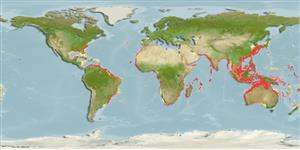Common names from other countries
Environment: milieu / climate zone / depth range / distribution range
Ökologie
seewasser; standorttreu; tiefenbereich ? - 350 m (Ref. 11897). Tropical
Western Atlantic: southeast Caribbean (Ref. 4496). Eastern Atlantic: Morocco to Namibia; reported from the Cape, South Africa (Ref. 4096). Mediterranean Sea: Lessepsian migrant (Ref. 85575). Indian Ocean and tropical western Pacific to Fiji (Ref. 4496).
The species has been misidentified as Bregmaceros atlanticus in all previous reports in the Mediiterranean Sea before 2017 (Ref. 85575).
Size / Gewicht / Alter
Maturity: Lm ? range ? - ? cm
Max length : 7.6 cm SL Männchen/unbestimmt; (Ref. 4496)
Rückenflossenstacheln (insgesamt): 0; Rückenflossenweichstrahlen (insgesamt): 42-56; Afterflossenstacheln 0; Afterflossenweichstrahlen: 42 - 55; Wirbelzahl: 47 - 52. Body is elongate, yellowish-white with a brownish stripe along each side of the back.
Neritic, probably undergo vertical migration. Migrates into and out of anoxic water on a diurnal basis.
Life cycle and mating behavior
Geschlechtsreife | Fortpflanzung | Ablaichen | Eier | Fecundity | Larven
Cohen, D.M., 1990. Bregmacerotidae. p. 524-525. In J.C. Quero, J.C. Hureau, C. Karrer, A. Post and L. Saldanha (eds.) Check-list of the fishes of the eastern tropical Atlantic (CLOFETA). JNICT, Lisbon; SEI, Paris; and UNESCO, Paris. Vol. 2. (Ref. 4496)
IUCN Rote Liste Status (Ref. 130435)
CITES (Ref. 128078)
Not Evaluated
Bedrohung für Menschen
Harmless
Nutzung durch Menschen
Mehr Information
NamenSynonymeMetabolismusRäuberÖkotoxikologieFortpflanzungGeschlechtsreifeAblaichenFecundityEierEientwicklung
ReferenzenAquakulturAquakultur ProfilZuchtlinienGenetikElectrophoresesVererbbarkeitKrankheitenVerarbeitungMass conversion
Tools
Zusatzinformationen
Download XML
Internet Quellen
Estimates based on models
Preferred temperature (Ref.
115969): 16 - 28, mean 23.7 (based on 1637 cells).
Phylogenetic diversity index (Ref.
82804): PD
50 = 0.5001 [Uniqueness, from 0.5 = low to 2.0 = high].
Bayesian length-weight: a=0.00372 (0.00152 - 0.00908), b=3.19 (2.97 - 3.41), in cm Total Length, based on LWR estimates for this (Sub)family-body shape (Ref.
93245).
Trophic level (Ref.
69278): 3.2 ±0.3 se; based on size and trophs of closest relatives
Fishing Vulnerability (Ref.
59153): Low vulnerability (10 of 100).
